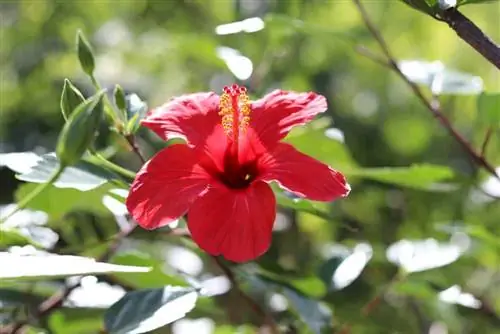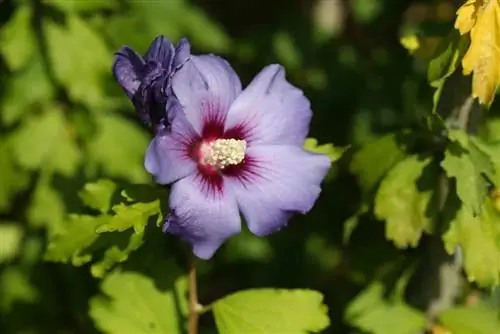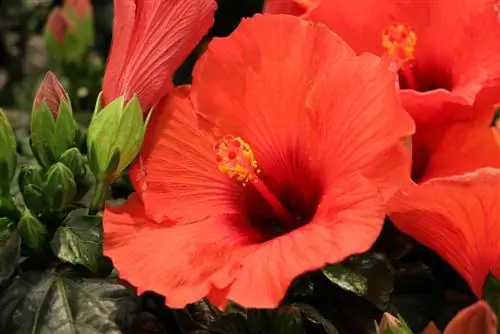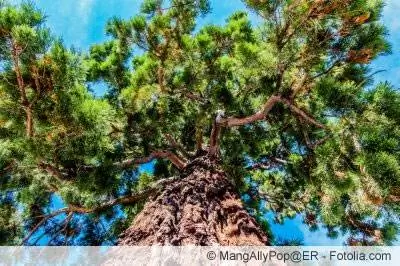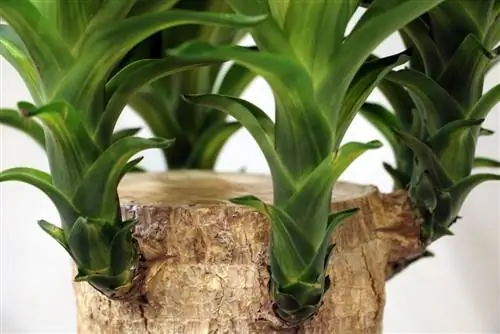- Author admin [email protected].
- Public 2023-12-17 03:39.
- Last modified 2025-06-01 06:48.
The hibiscus Newbiscus XXL is a unique type of hibiscus that is particularly notable for its huge flowers. With a diameter of almost 30 centimeters, it dwarfs many other perennials and is also frost hardy, which makes it easier to care for in winter. The mallow family is extremely thirsty, which is not surprising since the original hibiscus family comes from the East Asian tropics.
Location
The NewbiscusThe marshmallow was chosen as the starting plant because of the huge flowers that the hibiscus produces and can also be seen on the Newbiscus XXL. If you want to plant a specimen in your garden, similar conditions must exist to enable the plant to grow vigorously. The location for the plant should have the following properties:
- sunny to partial shade
- no blazing midday sun
- sheltered from the wind
- humus-rich
- evenly moist
If your soil is not rich in humus, you should first add nutrient-rich potting soil or compost to it. To do this, simply take a bag of potting soil or compost and mix it into the soil of the desired location. You can also improve the drainage of the site by adding additional brushwood or branches to the hole. This reduces the risk of waterlogging. Then put the hibiscus in its new place. The same type of substrate is needed if the hibiscus is kept in a pot. After planting in the pot, you should be careful not to move it during flowering, otherwise the heavy flowers could fall off.
Tip:
Provide the hibiscus Newbiscus XXL with a place with at least three hours of sun per day. This is particularly important if you want to get the full potential out of the plant.
Pouring
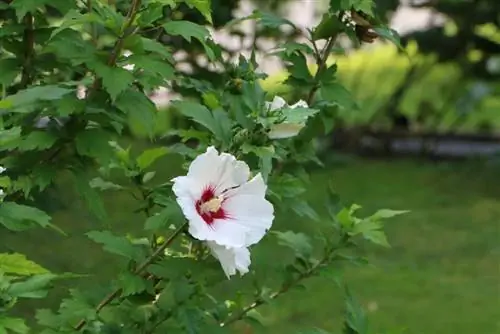
The hibiscus Newbiscus XXL is a particularly thirsty giant hibiscus whose location must never become too dry. Since the plant comes from the swamps and moors of the southern USA, the water supply must be kept constant. It is important to water regularly, even every day in summer. You have to orientate yourself on the substrate at the location, because the roots in particular must not dry out. If the roots dry out, the giant hibiscus can suffer greatly and even die.
Orient yourself to the hibiscus's soil every day and water it. The plant doesn't have any special demands on the water, so you can simply use tap water from the hose. Be sure to avoid waterlogging because the hibiscus doesn't want to drown. Too much water can result in the shoots drooping. If this happens, you should not water until the site is adequately moist again.
Tip:
Hibiscus Newbiscus XXL requires high humidity, which can be a problem in many northern areas in Germany. Therefore, spray the plant with fresh water every now and then to increase the humidity.
Waterlogging can also manifest itself in the plant disease chlorosis, in which the leaves become yellowish and have green veins. Reduce watering significantly here and change the substrate if necessary.
Fertilize
Due to the numerous flowers, the hibiscus needs regular fertilization to support he althy growth. It is best to use an inorganic flower or flower fertilizer for the plant, for example from Compo or Chrysal. The main thing is that the magnesium content in the fertilizer is high. Do not add the fertilizer directly into the substrate or onto the plant, as this would over-s alt it. It is safer to add it via the irrigation water.
This allows the roots to better absorb the important nutrients and then process them. The hibiscus Newbiscus Pay attention to the dosage of the respective fertilizer so as not to over-fertilize the plant. Due to its robustness, the hibiscus can tolerate excessive fertilization from time to time, but too much fertilizer should always be avoided.
loose up the soil
Due to the dense growth of the roots, the substrate of the giant hibiscus should be loosened every now and then, because the plant only grows well in permeable substrate. The looser the soil, the easier it is for the hibiscus to grow. The soil is loosened in May before the first sprouting and after sprouting. This will increase the growth even further and with the right pruning you can look forward to an extremely bushy plant with bright flowers. After loosening, simply continue with the usual care.
Propagate
The giant hibiscus is not propagated from seeds, but from cuttings. These prove to be very good for growing more specimens from the same plant. Since the giant hibiscus grows as a perennial, there are enough shoots that can be used as cuttings and make growing a new specimen really easy. To do this, simply use the shoot tips that you removed during one of the annual prunings. After cutting the plant, proceed as follows to take the cutting:
- Free the cutting of small branches, buds and dirt.
- Prepare a pot of nutrient-rich potting soil that is about 20 centimeters deep and diameter. To do this, use the same substrate that you would use for your adult specimens.
- Now embed the cutting in the soil and cover the shoot generously with soil.
- Now follows extensive watering. Fertilizer should be avoided until this point as the cutting will not produce any flowers yet.
- Do not place the pot outdoors during the winter if you are using shoot tips from autumn pruning. The cutting cannot grow in the cold and should be kept either in the winter garden, greenhouse or in your own premises.
- After the first shoots appear and it is warm enough outside for the hibiscus Newbiscus XXL, it can be repotted or placed in the garden. Please continue to pay attention to the correct substrate and the necessary amount of water.
- You can only fertilize when buds appear on the shoots, from mid-May at the earliest.
Cut
With its lush flowers, the hibiscus Newbiscus XXL is the highlight in every garden. In order to promote this growth and allow the plant to bloom attractively in the garden, pruning is necessary, which is carried out twice a year. These are carried out in late October, when the plant's trunks turn brown and dry, and in late May to early June, when the first fresh shoots appear.

In addition, wilted flowers should be removed during the flowering period, which protects the hibiscus from a loss of energy. Due to the gigantic size of the flowers of the Newbiscus XXL, large amounts of energy are withdrawn from the plant, which explains the frequent use of fertilizer. By removing the withered flowers, you can save the energy that the hibiscus would otherwise have to use to maintain them. To prune, simply use clean secateurs and remove the flowers without moving the plant.
The pruning - instructions
- For pruning, choose clean secateurs that can also handle slightly thicker branches.
- When pruning in October, the shoots that are brown and dry are cut off. Since the giant hibiscus grows as a perennial but isn't actually one, it will lose all of its greenery anyway, so you can cut back heavily.
- Cut the shoots back to a length of 20 to 30 centimeters. Do this carefully and do not leave any shoots too long, otherwise the roots could suffer in winter.
- Then remove the cut greenery and prepare the winter protection.
- In May, when the first shoots sprout, you can then remove the remaining shoots from the previous year. These can still be recognized by their dark color, which stands out in contrast to the fresh shoots in spring green.
- Work here again thoroughly and remove all shoots and then the cut greenery. The cut ensures effective growth of the plant, which is reflected in many leaves and even more flowers like last year.
- After pruning in May, continue with the care instructions above as follows. Don't forget to water the plant thoroughly now.
Wintering
Even though the hibiscus Newbiscus XXL is a hardy plant that can easily withstand temperatures of up to -15°C, it should not be sent into the winter without preparation. Since it is a special breeding form of the classic giant hibiscus, which is actually only moderately hardy, a winter that is too cold without protection can be harmful to the roots. Even before pruning in October, the giant hibiscus will lose all of its leaves and dry out more and more, which is the sign of preparation for winter.
If you keep your giant hibiscus in a pot, you should simply place the entire plant in the winter garden or greenhouse, even the apartment is suitable for this. Over the winter, the potted plant is no longer fertilized and watered regularly, but the amounts are significantly lower. Winter protection for specimens in the garden is prepared as follows:
- After cutting the plant, you should either use compost, bark mulch or lots of leaves as thermal insulation.
- Spread the winter protection generously at the plant's location in an appropriate thickness. More actually makes sense with the giant hibiscus.
- Ensure that the giant hibiscus still receives light in winter and is protected from wind, snow and rain by a roof in areas that are too wet. If necessary, the plant should be moved.
- In spring, the plant should not get too wet either. Protect from rain and condensation.
More
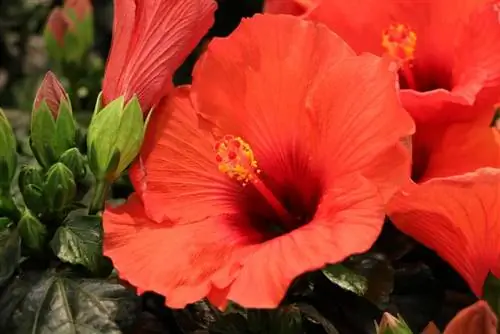
Despite its robust nature and winter hardiness, the hibiscus Newbiscus XXL can suffer from certain problems. It has the advantage that pests are not interested in the plant and therefore no countermeasures against spider mites or aphids are required. Never turn the flowers of the hibiscus while it is blooming, otherwise the flowers will fall off within a short time. Never store your giant hibiscus in too dark a place.
Even if it cannot tolerate full midday sun, darkness is more dangerous for the plant. The mallow plant should also be positioned away from flowering or fruit-bearing plants. The reason for this lies in the ethylene secreted by these plants. They hinder the growth of the plant and promote the loss of flower buds. Likewise, you should never store potatoes, bananas, apples or similar fruits near the giant hibiscus as they will have the same effect on the hibiscus.
Tip:
Watch your giant hibiscus in the early hours of the morning and you will be amazed by the spectacle that awaits you. From the first rays of sunshine, the plant begins to open its flowers, which takes about 90 minutes and is really interesting.

